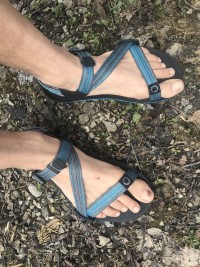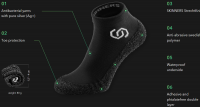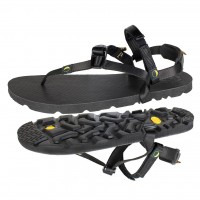November 2019
This review is for the 46mm model of the COROS Apex. COROS sent me a loaner unit for testing and review, which was returned to the company at the conclusion of testing.
There are a few key differences between the 46mm and 42mm Apex I would like to address upfront. Aside from the obvious size difference, a minor difference in weight (55.3 vs 50.8 grams), and $50 difference in cost the 42mm model has a ceramic bezel whereas the 46mm has a more durable bezel fabricated from a titanium alloy. The key difference, however, is battery life.
Features
| 46 mm | 42 mm | ||
| Up to 100 Hours in UltraMax GPS Mode | Up to 80 Hours in UltraMax GPS Mode | ||
| Up to 35 Hours in Full GPS Mode | Up to 25 Hours in Full GPS Mode | ||
| Up to 30 Days for Regular Use | Up to 24 Days for Regular Use |
With key differences out of the way the ‘as advertised’ features are:
| APEX 46mm | |||
| Display Size | 1.2 in. 240 x 240 (64 colors) | ||
| Display Type | Memory LCD | ||
| Screen Material | Sapphire Glass | ||
| Bezel Material | Titanium Alloy | ||
| Strap Material | Silicone | ||
| Quick Release Bands | 22mm | ||
| Physical Size | 48.50 x 48.50 x 13.75 mm | ||
| Weight | 55.3 g | ||
| Wireless Connection | BT4.2 BLE for smartphone only, ANT+ for accessories | ||
| Navigation | GPS, GLONASS, BDS | ||
| Sensors | Optical Heart Rate Monitor | ||
| Barometric Altimeter | |||
| Accelerometer | |||
| Gyroscope | |||
| Compass | |||
| Water Resistance | 10ATM (100 Meters/328 Feet) | ||
| Working Temp | 14°F to 131°F (-10°C to 55°C) | ||
| Storage Temp | ‘-4°F to 149°F (-20°C to 65°C) | ||
| Charging Time | Less than 2 Hours |
Color Display and Ergonomics
The full color display was easy to read even in lower light conditions. The display size is adequate without being overly cumbersome.
The Apex has just two buttons. Movement between screens is controlled by a digital knob on the upper right side of the watch. The knob can be depressed as a button and can be rotated which will toggle between screens.
The COROS Apex 46mm is very comfortable and lightweight. Whereas Garmin and Suunto’s versions with similar battery life are much bulkier, the Apex provides ultra-worthy battery span with the comfort of a Fitbit. After growing accustomed to much heftier GPS watches I caught myself glancing down at times to make sure I even put my watch on for a run.
Watch Faces
There are plenty of choices to customize your watch face whether you prefer something simple and elegant or loud with every bit of data piled on to the screen.
Activity Profiles
Scrolling between screens is easy in daily tasks, but when it comes to running or cycling it is cumbersome. I found the fine movements necessary to deftly switch between screens to be difficult while running and opted to use the custom screens option to put my most important data on one screen.

The custom screens include options for:
- Run
- Trail Run
- Indoor Run
- Bike
- Indoor Bike
- Hike
- Swim (open water)
- Pool Swim
- Triathlon
Up to 6 fields can be assigned per screen with multiple screens available, though I would only recommend using all 6 fields on one screen if you have the vision of a hawk as the data fields are far too small for my eyes. For me 4 data fields or less per screen provided a nice balance of ease of reading and providing key data.
Optical Heart Rate
Optical HR has never seemed to work well for me. While it is generally dead on for daily monitoring and sleep, which is great for assessing recovery, while running I almost always get data in Z5. Hard sprints? Z5. Easy recovery run? Z5. Tempo run? Z5. You get the picture. This is an anomaly I have seen with all optical HR watches I have tried. I did not have a chest strap paired to the COROS Apex, though I am certain that would yield better results. Also noteworthy, the Apex can be paired to a strap with ANT+. The lack of valid HR data meant that estimates from the trainer feature were likely not anywhere in the ballpark. Again, I tend to have issues with all optical HR watches so I don’t count this as a strike against COROS.
Geo-positioning
The COROS Apex features positioning capabilities from GPS, GLONASS, and BDS. Depending primarily on where you live each has it’s advantages and disadvantages.
- GPS – US-based. Generally a minimum of 24 satellites provide positioning
- GLONASS – Russia-based. Due to positioning GLONASS has better coverage for those living at high latitudes either far north or south.
- BDS – China-based. BDS uses geosynchronous orbiting satellites which require less satellites overall, but is only good for areas with coverage. For Chinese users this is a nice feature and in the future the BDS system may rival GPS and GLONASS worldwide.

Training
I tested the COROS Apex for road running, trail running, and pool swimming. The performance was good in each discipline.
Running
All the meat and potato data field options are there for data geeks to lose their minds over.
For me I prefer a few key data fields. For trail training and racing alike I want distance, average pace, lap pace, duration, and ascent.
When it comes to roads I want distance, average pace, lap pace, and duration.
The Apex was so light and comfortable I hardly noticed it there. You won’t need to worry about having one beefed-up arm from swinging it with a 5 pound watch attached.
Swimming
Options available allow you to switch the Apex between a few standard pool distances for calculating laps. but also to add your own for that freaky 21 meter pool. I’m looking at you LA Fitness.
As a new swimmer my form leaves something to be desired and at first my distances were all over the place. After a few lessons I found the COROS Apex to accurately record my pool laps.
The run for which data is presented here was on a very hot and humid day. I was drenched by mile 2. It was an easy effort run and you can see my issue with the heart rate clearly. I was in zone 2 by feel, possibly tapping into low Z3. That aside , the rest of the data was on point.
The Verdict
The COROS Apex packs a whole lotta watch at a more than reasonable price point. The Apex will help you train for that first 5k and give you enough battery for your first 100 miler as well. It has plenty of desirable features without loading you down in minutiae of a million changeable settings. This watch is intuitive, easy, and above all functional. Garmin and Suunto have a new challenger.















Leave A Comment